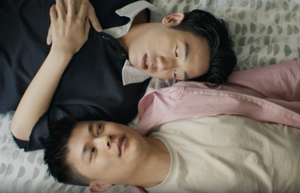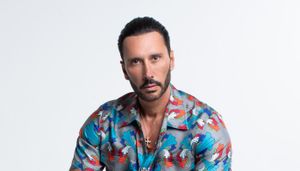CONTACTStaffCAREER OPPORTUNITIESADVERTISE WITH USPRIVACY POLICYPRIVACY PREFERENCESTERMS OF USELEGAL NOTICE
© 2025 Pride Publishing Inc.
All Rights reserved
All Rights reserved
By continuing to use our site, you agree to our Private Policy and Terms of Use.
A survey of U.S. gay men presented this week at the 14th Conference on Retroviruses and Opportunistic Infections reveals that gay men born in the 1970s (and therefore now in their 30s) knew they were gay, came out earlier, and had their first boyfriend earlier than gay men of previous generations.
But it also finds that older gay men (born in the 1940s, and therefore now in their 60s) had just as much, if not more, sex as adolescents and had it just as early.
The survey also found that younger gay men were more likely to have started their sexual adventures by having oral rather than anal sex and were much more likely to have had sex with a woman before they started having sex with men.
The researchers comment that this means that younger gay men have had a "broader early sexual repertoire," though if they count oral sex as having a broad repertoire, it begs the question as to what they think a narrow one might be.
The age-stratified survey of gay men was part of a study called the Urban Men's Health Survey, an annual quiz of gay men conducted in 15 U.S. cities. It was presented February 25-28 in Los Angeles.
Three statistics suggested that being young and gay has, if anything, become more difficult over the years. The proportion of men who said they'd been harassed at school for being gay increased from three out of five born before 1940 to four out of five born after 1970.
The number who said they'd experienced child sex abuse increased from 12% to 19%. And twice as many men born after 1970 had attempted suicide before the age of 18 compared with those born before 1940--6% versus 3%.
The survey interviewed 2,881 men who said they'd had sex with another man over the last year. It excluded, for this age analysis, the 157 who were under 25 and about 700 (a quarter of the sample) who didn't define themselves as gay. This left 2,024 men.
Their average age was 40, seven eighths of them were white, and most were born between 1940 and 1970, with 7% each born before 1940 or after 1970.
About 70% said they were HIV-negative, 20% HIV-positive, and 10% said they didn't know their status.
As you might expect, the average age at which men wondered if they were gay, decided they were, came out to others, and got serious about a boyfriend declined over the years.
For instance, men born before 1940 didn't start even wondering if they were gay till they were over 17, made the firm decision by the age of 22, and came out to family (if they did) at 25--having acquired their first serious boyfriend before coming out at the age of 23.
Men born after 1970 wondered if they were gay before they were 13, had decided they were by 17, and came out at 19 before having their first serious relationship at about 19 and a half years old.
On the other hand, just because men born in the 1940s came out to themselves and others later didn't mean they were having less sex. The number who'd had more than 25 partners before the age of 18 declined significantly from 13% of men born before 1940 to 4% of men born after 1970.
And the number whose first sex was with another man declined from 80% of those born before 1940 to 65% of those born after 1970. Anal sex remained just as fashionable over time, but the proportion whose first sex was oral sex increased from 48% of those born before 1940 to 72% of those born after 1970.
Of course the latter would be starting to have sex in the late 1980s and early '90s, when the fear of AIDS was at its peak.
Another branch of the same survey, which included men under 25, found that between 5% and 11% of gay men in the 15 cities who'd previously taken an HIV test believed themselves to be negative when they were in fact positive.
More than 90% of the men had taken an HIV test at some point, and two thirds of them had been tested in the last year--a far higher proportion than in Europe.
Of the ones who had been tested, 79% said they were negative, 15% positive, and 6% said they hadn't dared go back for their result.
When the men were given an oral HIV test, it turned out that in fact 26% were positive, with nearly half of these (12% of all men who'd ever been tested) being newly diagnosed. The federal Centers for Disease Control and Prevention has recommended that in the light of these findings, gay men should get tested for HIV at least once a year.
This was underlined by a third study from New York which found that gay men have by far the highest risk of acquiring new HIV infections of any group.
By using an assay that detects recent infection in people coming to get tested at New York City's STD clinics, a group from the New York Public Health Department found that HIV incidence--the proportion of people who get new infections--was 3% a year in gay men, 1.7% a year in injecting drug users, and 0.25% a year in heterosexuals.
The peak age for infection was 35-39. Black people were still the ethnic group most likely to acquire HIV, but their incidence rate had declined from 0.7% a year in 2000 to 0.28% in 2004 and was now not greatly in excess of that seen in Latinos, though still twice the rate in white people.
Incidence had declined in all groups except gay men, where an initial decline from 3.8% a year in 2000 hadn't been sustained and had stayed at 3% a year. In other words, one in 35 gay New Yorkers a year becomes HIV-positive. (Gus Cairns, Gay.com/U.K.)
From our Sponsors
Most Popular
31 Period Films of Lesbians and Bi Women in Love That Will Take You Back
December 09 2024 1:00 PM
18 of the most batsh*t things N.C. Republican governor candidate Mark Robinson has said
October 30 2024 11:06 AM
True
After 20 years, and after tonight, Obama will no longer be the Democrats' top star
August 20 2024 12:28 PM
Trump ally Laura Loomer goes after Lindsey Graham: ‘We all know you’re gay’
September 13 2024 2:28 PM
Melania Trump cashed six-figure check to speak to gay Republicans at Mar-a-Lago
August 16 2024 5:57 PM
Latest Stories
America's best cities for tops and bottoms, according to Squirt
December 30 2024 9:33 PM
Judge rules against gender-affirming care for transgender prisoners
December 30 2024 8:02 PM
Pete Buttigieg remembers warmth and kindness of Jimmy and Rosalynn Carter
December 30 2024 3:59 PM
19 LGBTQ+ movies & TV shows coming in January 2025 & where to watch them
December 30 2024 3:54 PM
Man arrested under Russia's 'international LGBT extremism' law dies in custody
December 30 2024 3:24 PM
Stonewall started it—but who writes the next chapter?
December 30 2024 11:00 AM
J.K. Rowling falsely claims 'there are no trans kids'
December 30 2024 10:12 AM
Why we will never have another president like Jimmy Carter again
December 29 2024 6:19 PM
President Jimmy Carter dead at 100 — here's his history as an LGBTQ+ ally
December 29 2024 4:50 PM
Don't be 'weak & gay': Republican announces congressional run with controversial video
December 27 2024 3:51 PM
'A Complete Unknown's Timothée Chalamet, Monica Barbaro on music, gender & protest
December 27 2024 2:57 PM
Gender studies pioneer Judith Butler: Trans women won't erase cis women
December 27 2024 1:01 PM
Kyrsten Sinema defends filibuster in farewell address to Senate
December 26 2024 7:48 PM
Queer Latina-owned lemonade shop in San Antonio gets a business-saving grant from HRC
December 26 2024 5:22 PM
Abercrombie & Fitch’s former CEO Mike Jeffries has dementia, his lawyers say
December 26 2024 3:03 PM
Georgia couple sentenced to 100 years in prison for sexual abuse of adopted kids
December 26 2024 2:37 PM
Trending stories
Recommended Stories for You


















































































